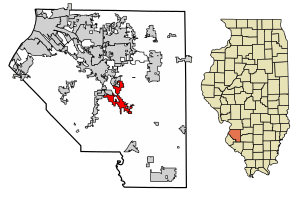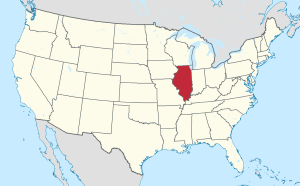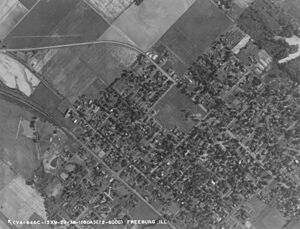Freeburg, Illinois facts for kids
Quick facts for kids
Freeburg
|
|
|---|---|

Location of Freeburg in St. Clair County, Illinois.
|
|

Location of Illinois in the United States
|
|
| Country | United States |
| State | Illinois |
| County | St. Clair |
| Area | |
| • Total | 7.10 sq mi (18.39 km2) |
| • Land | 6.84 sq mi (17.73 km2) |
| • Water | 0.26 sq mi (0.66 km2) |
| Elevation | 518 ft (158 m) |
| Population
(2020)
|
|
| • Total | 4,582 |
| • Density | 669.49/sq mi (258.47/km2) |
| Time zone | UTC-6 (CST) |
| • Summer (DST) | UTC-5 (CDT) |
| ZIP Code(s) |
62243
|
| Area code(s) | 618 |
| FIPS code | 17-27806 |
| GNIS feature ID | 2398923 |
| Wikimedia Commons | Freeburg, Illinois |
| Website | http://www.freeburg.com |
Freeburg is a small village located in St. Clair County, Illinois, United States. It's part of the larger Greater St. Louis area. Many people who live in Freeburg travel to Downtown St. Louis or nearby Belleville for work. In 2020, about 4,582 people lived in Freeburg.
Contents
History of Freeburg
Freeburg is in the rich, rolling plains of southern Illinois. It sits between the Kaskaskia River and the Mississippi River. The village was first planned in 1836. It was called Urbana by settlers who came from Virginia around 1800. The first European settlers in Freeburg were from England and Ireland.
Early Native American Presence
Long ago, five different Native American tribes lived in or traveled through Illinois. These included the Peorias, Cahokias, Kaskaskias, Tamaroas, and Michiganics. A place called Turkey Hill, north of town, was a popular Native American campsite. Early settlers also liked it because it offered great views of the area. The last Native American tribes left this region by 1820.
German Settlers and Growth
Around 1830, many German people started moving to the Freeburg area. They were drawn by the large amounts of coal and cheap, good farmland. They also liked being close to St. Louis, a growing city about 20 miles away. German migration continued steadily for the rest of the 1800s.
In the 1850s, a special "Plank Road" was built. For 35 cents, people could travel comfortably from Belleville to Freeburg. This road had no potholes and is now known as the old Freeburg Road. It is said that Abraham Lincoln used this road at least once.
Changing Names and New Connections
In 1851, Freeburg got its own post office. But there was already another town named Urbana in Illinois. So, in 1859, the town leaders changed the name to Freeburg. They named it after Freiburg in Baden, Germany. Many of the early German settlers had come from that region.
The town officially became a village in 1867, with 808 people living there. The railroad arrived in 1869. It changed owners several times before being sold to the Illinois Central company.
The Coal Mining Era
At one time, Freeburg was a busy coal mining town. As many as 1500 miners lived there. In 1874, there were 10 hotels for them to stay in. The Peabody River King Mine, just east of Freeburg, closed in 1989. After that, coal mining was no longer the main part of the local economy.
The River King Mine Train at Six Flags St. Louis was named after the River King Coal Mine in Freeburg. This mine was operated by Peabody Coal from 1957 to 1989. After it closed, Peabody donated about 1,800 acres of the mine site to the Illinois Department of Natural Resources in 1994. This area is now the Peabody-River King State Fish and Wildlife Area. It's open to the public for fishing, hunting, and other outdoor activities.
Today, Freeburg has many different types of businesses. It also serves as a "bedroom community" for people who work in Belleville and the St. Louis area. The village still provides all the important services a small community needs.
Geography of Freeburg
Freeburg is located at 38°25′37″N 89°54′38″W / 38.42694°N 89.91056°W.
In 2010, Freeburg covered about 7.025 square miles (18.39 square kilometers). Most of this area, about 6.77 square miles (17.73 square kilometers), is land. The rest, about 0.255 square miles (0.66 square kilometers), is water.
Freeburg used to be mainly a farming community. But as nearby cities like Belleville and Fairview Heights grew, parts of Freeburg developed. Now, some areas look like typical suburbs with new neighborhoods.
Freeburg has a low crime rate, especially compared to cities north of it. Because of this, many people who work in St. Louis, Missouri choose to live in Freeburg. They enjoy the short commute and the value of the land.
Climate in Freeburg
The weather in Freeburg has hot, humid summers and generally cool winters. According to the Köppen Climate Classification system, Freeburg has a humid subtropical climate. This type of climate is often shown as "Cfa" on climate maps.
| Climate data for Freeburg, IL | |||||||||||||
|---|---|---|---|---|---|---|---|---|---|---|---|---|---|
| Month | Jan | Feb | Mar | Apr | May | Jun | Jul | Aug | Sep | Oct | Nov | Dec | Year |
| Mean daily maximum °F (°C) | 40.5 (4.7) |
45.5 (7.5) |
56.4 (13.6) |
67.8 (19.9) |
76.8 (24.9) |
85.6 (29.8) |
89.0 (31.7) |
88.2 (31.2) |
81.1 (27.3) |
69.9 (21.1) |
56.8 (13.8) |
43.3 (6.3) |
66.7 (19.3) |
| Mean daily minimum °F (°C) | 22.2 (−5.4) |
25.6 (−3.6) |
34.8 (1.6) |
45.0 (7.2) |
54.8 (12.7) |
63.9 (17.7) |
67.7 (19.8) |
65.5 (18.6) |
56.6 (13.7) |
45.9 (7.7) |
36.1 (2.3) |
25.7 (−3.5) |
45.3 (7.4) |
| Average precipitation inches (mm) | 2.4 (61) |
2.5 (64) |
3.4 (86) |
3.9 (99) |
4.8 (120) |
4.3 (110) |
4.2 (110) |
3.4 (86) |
3.4 (86) |
3.5 (89) |
4.2 (110) |
3.1 (79) |
43.1 (1,100) |
| Average snowfall inches (cm) | 3.9 (9.9) |
3.5 (8.9) |
1.0 (2.5) |
0.3 (0.76) |
0 (0) |
0 (0) |
0 (0) |
0 (0) |
0 (0) |
0 (0) |
0.3 (0.76) |
3.1 (7.9) |
12.1 (30.72) |
| Average precipitation days | 6.5 | 6 | 9 | 10 | 11 | 9 | 7 | 7 | 6.5 | 8 | 8 | 8 | 96 |
| Average snowy days | 2 | 2 | 0.5 | 0.1 | 0 | 0 | 0 | 0 | 0 | 0 | 0.1 | 2 | 6.7 |
| Source: NOAA | |||||||||||||
Population and People
| Historical population | |||
|---|---|---|---|
| Census | Pop. | %± | |
| 1860 | 560 | — | |
| 1870 | 920 | 64.3% | |
| 1880 | 1,038 | 12.8% | |
| 1890 | 848 | −18.3% | |
| 1900 | 1,214 | 43.2% | |
| 1910 | 1,397 | 15.1% | |
| 1920 | 1,594 | 14.1% | |
| 1930 | 1,434 | −10.0% | |
| 1940 | 1,507 | 5.1% | |
| 1950 | 1,661 | 10.2% | |
| 1960 | 1,908 | 14.9% | |
| 1970 | 2,495 | 30.8% | |
| 1980 | 2,989 | 19.8% | |
| 1990 | 3,115 | 4.2% | |
| 2000 | 3,872 | 24.3% | |
| 2010 | 4,354 | 12.4% | |
| 2020 | 4,582 | 5.2% | |
| U.S. Decennial Census | |||
The population of Freeburg has grown steadily over the years. In 1860, about 560 people lived here. By 2020, the population had reached 4,582.
According to the census from 2000, there were 3,872 people living in Freeburg. Most residents were White. A small number of people were African American, Native American, Asian, or from other backgrounds. About 1.11% of the population was Hispanic or Latino.
Many households in Freeburg were married couples living together. About 39.2% of households had children under 18. The average household had about 2.65 people. The average family had about 3.08 people.
The population included people of all ages. About 27.1% were under 18 years old. About 14.6% were 65 years or older. The average age in the village was 38 years.
Education in Freeburg
Freeburg has several schools and a public library for its residents.
- Freeburg Elementary School
- Freeburg Community High School
- St. Joseph Catholic School
- Public library
Notable People from Freeburg
Some well-known people have come from Freeburg:
- Danny Cox, a former pitcher for the St. Louis Cardinals baseball team.
- Dutch Hoffman, an outfielder who played for the Chicago White Sox baseball team.
Freeburg in Film
A cafe called Jeanies, which used to be on the northern edge of town, was used for filming. It appeared in the movie In the Heat of the Night. The cafe has since been torn down.
See also
 In Spanish: Freeburg (Illinois) para niños
In Spanish: Freeburg (Illinois) para niños



